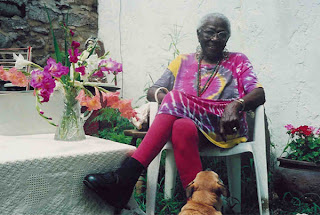A new scholarship this fall at the Pennsylvania Academy of the Fine Arts honors the late Selma Burke, a Bucks County sculptor whose work is familiar if you’ve ever studied your change.
That picture of Franklin Delano Roosevelt on the dime? It bears an uncanny resemblance to a bas-relief that Burke formed of FDR.
That picture of Franklin Delano Roosevelt on the dime? It bears an uncanny resemblance to a bas-relief that Burke formed of FDR.
Until her death 16 years ago at age 94, Burke would tell visitors to her Solebury Township studio of the presidential commission she won over 11 other sculptors.
Lewis Tanner Moore, the Warrington collector of African American art, said Burke often recalled the day in 1944 when she unrolled a sheet of butcher paper across the Oval Office and sketched Roosevelt for 45 minutes in charcoal, while reminding him to sit still.
Her bronze relief of him has hung since 1945 at the Recorder of Deeds Building in Washington. Burke’s pride turned to outrage a year later, when the U.S. Treasury Department released a coin to honor the late president.
The design, by John Sinnock, the U.S. Mint’s chief engraver, looked suspiciously like Burke’s. She complained, but was never credited.
Numismatists have debated her contribution ever since. But there was no question in her mind – or Moore’s. She was robbed.
“The engraver needed something,” Moore said. “He used her artwork.”
The story of the coin figures prominently in the efforts of Burke’s followers to keep her name alive and raise money to promote young African American artists. Moore asked artist Faith Ringgold if she would make a print that members of the newly formed Selma Burke Sculpture Foundation could sell to fund the yearly $12,500 scholarship.
The story of the coin figures prominently in the efforts of Burke’s followers to keep her name alive and raise money to promote young African American artists. Moore asked artist Faith Ringgold if she would make a print that members of the newly formed Selma Burke Sculpture Foundation could sell to fund the yearly $12,500 scholarship.
Ringgold produced an edition of 65 prints, each costing $1,100. She titled her work:
Dear Selma, every time I see a dime I think of you.
Dear Selma, every time I see a dime I think of you.
Burke didn’t need credit for the coin in order to be memorable, Moore pointed out. She lived art history, flowering in the Harlem Renaissance of the ’20s and ’30s, studying in Paris with Henri Matisse and Aristide Maillol, starting two schools of sculpture, teaching at Haverford and Swarthmore.
What Moore cherishes most about Burke is their friendship. During her last 15 years, Moore and his wife would call on the sculptor every few weeks. She cooked wonderfully, he says. Sometimes she’d hand him money to buy a good bottle of wine, then chide him if it wasn’t quite good enough.
“She was gracious and kind and a wonderful storyteller.”
“She was gracious and kind and a wonderful storyteller.”

